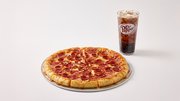Article
How Wendy's dethroned The King
Burger King's identity crisis in 2008 and the commensurate sales slide left the chain vulnerable for a revolution.

December 21, 2011 by Alicia Kelso — Editor, QSRWeb.com
Ronald McDonald may not need to look over his shoulder yet, but now that the girl with the red pigtails has passed the king in the burger wars, there's no denying that a massive shift has occurred in the QSR industry.
Burger King and Wendy's, the perennial No. 2 and No. 3, respectively, have jockeyed positions for the first time ever.
The takeover was predicted in late November, by an analyst with Janney Capital Markets. Technomic pulled numbers this week for The Wall Street Journal that confirmed the shift.
Considering the chains' extensive histories – Burger King has been around since 1953, while Wendy's was founded in 1969 – the news is intriguing for many reasons. Did something go wrong at Burger King? Did Wendy's do something right? Will Burger King now be left in the dust?
In short: Yes, yes and no, not likely.
What happened at Burger King:BK began its downward trend – as did most businesses – around the peak of the recession, between 2008 and 2010. Essentially the brand was hurt more than most because of its targeted demographic – the young, male consumers were hit hard by high unemployment rates.
It didn't help that the chain's mascot, The King, conceived by BK's former AOR Crispin, Porter and Bogusky, targeted that narrow base and was considered by others to be "creepy" and disconnected. Simply put, the marketing ploy turned off a big chunk of consumers. Wendy's launched its popular "You Know When It's Real" tagline around the same time, touting fresher, higher quality ingredients.
Also of note was a relative stagnancy in product innovation at Burger King. While the brand tinkered with Angry Whoppers and ribs, McDonald's McCafe line skyrocketed and Wendy's debuted premium salads and began testing variations of its popular Frosty.
Also, Burger King's former owners grappled publicly with its franchisees – a cardinal sin in the business world. The National Franchisee Association's class action suit in 2009 dragged on until the new ownership – 3G Capital – settled earlier this year. But two years of a strained relationship has its effects and unhappy franchisees translate into unhappy customers.
Finally, Burger King dealt with a change in management within the past 18 months. The new leadership has a new philosophy and plenty of interesting ideas, but transitions take time to translate successfully.
What happened at Wendy's: Meanwhile, Wendy's "You Know When It's Real" campaign appealed to a broad base of consumers increasingly demanding higher quality from their QSR meals. Wendy's embrace of "perceived to be healthy" items has helped boost the brand as a consumer favorite (most popular) as ranked by Zagat through the recession and into present-day.
On an innovation level, the brand took a risk in changing its french fry recipe, launched new versions of its Frosty, rolled out premium salads, upgraded its burger line and reinvented its breakfast line. As Denny Lynch, Wendy's SVP of communications, said in an August interview: "We're not just improving our ingredients, we're totally reengineering them. It's not a product improvement, it's a total reimaged product. It is part of a brand strategy that has been two years in the making."
Also, as Burger King spent the past year transitioning under its new leadership, Wendy's sold the Arby's brand specifically to shift the focus solely on its fundamentals, an obvious advantage.
This horse race isn't over:Just because Wendy's is projected to finish 2011 with higher annual systemwide sales doesn't mean Burger King will be left in the dust at No. 3. Expect a horse race between the two brands for the foreseeable future. Consider:
- Burger King's owner, 3G Capital, has had a little more than a year to turn the ship around and the company has made fundamental changes of note, including a continued menu enhancement and a new marketing strategy (The King is dead) spearheaded by a new agency.
- Burger King has patched things up with its franchise base, settling the dragged out class action suit out of court.
- Although Wendy's may have a healthier perception, Burger King was ahead of the game in rolling out better-for-you kids meal options in 2009, and was one of the inaugural participants in the National Restaurant Association, Health Dining Kids LiveWell initiative.
- Both brands are putting a lot of effort into finding a spot in the hot coffee space. Wendy's is testing a proprietary blend called Redheaded Roasters, while Burger King has the weight of Seattle's Best on its menus.
- Nearly a year after Wendy's debuted its new natural-cut sea salt fries, Burger King also rolled out a new version of its fries.
- Wendy's can leverage its popular Frosty – and new variations such as Wild Berry and Oreo Parfait – while Burger King finds its dessert footing with a new soft-serve line.
- Wendy's is testing four modern restaurant prototypes that include subtle lighting, comfortable lounge-like seating, flatscreen televisions, fireplaces and earthy, modern design elements. Burger King is in the middle of a new 20/20 restaurant design rollout with similar features. BK's reimaging program is expected to accelerate after 3G Capital submitted a more affordable plan for franchisees.
- Both brands are setting their sites on international shores. Wendy's planted a flag in Russia in 2011, while BK named a master franchisee in Brazil. This is just the tip of both brands' global executions and strategies. Currently, Burger King's international footprint is much larger – 10-to-1 – than Wendy's.
Will either brand gain ground on McDonald's? According to Technomic's Darren Tristano, if you combined Wendy's and Burger King's domestic sales from this year, it would still equal about half of what McDonald's will pull in. So, the runner-up spot, for now, is where this race will take place.
Read more about trends and statistics.
Photo provided by fotopedia.









